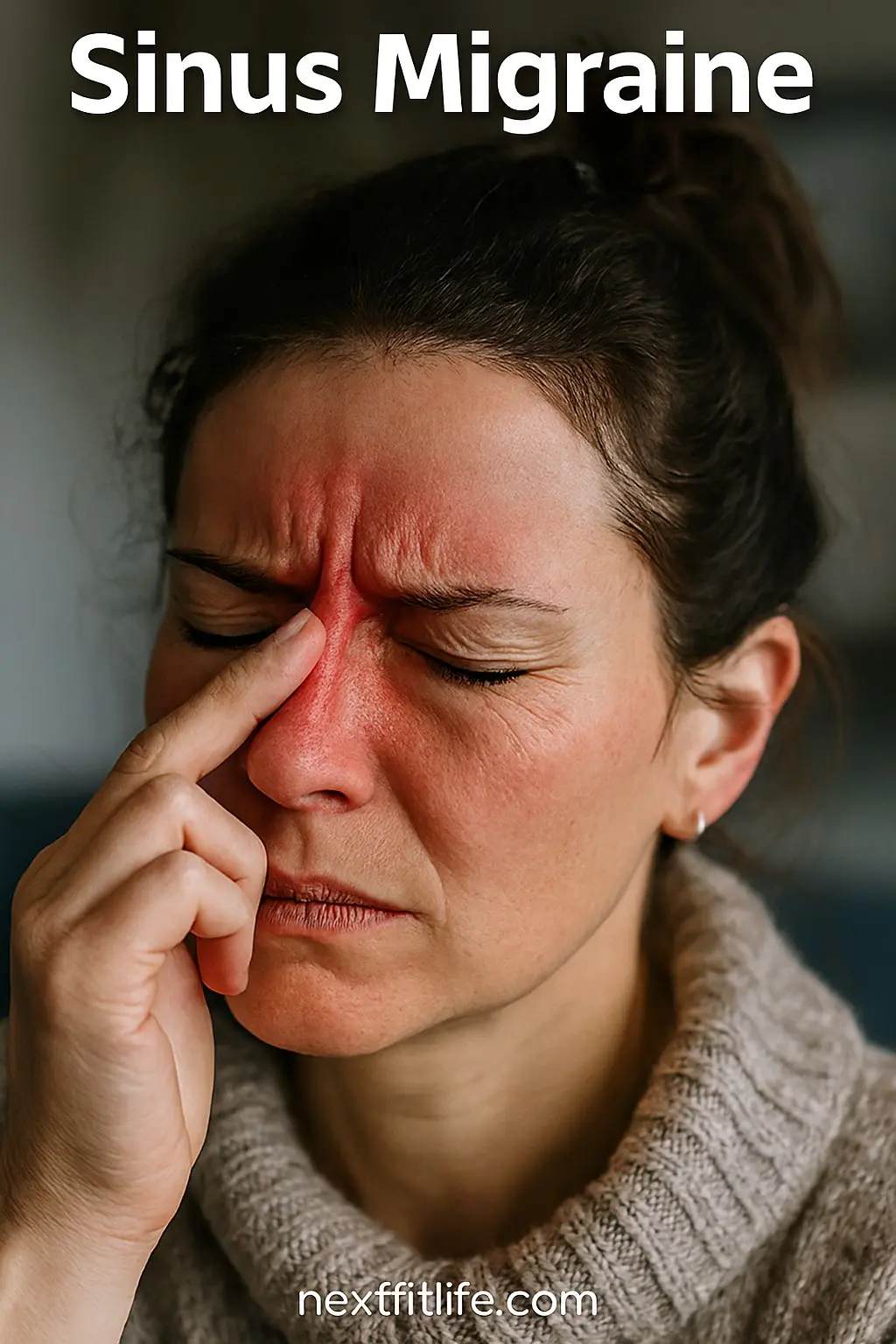Sinus migraine causes intense facial pressure, nasal congestion, and throbbing head pain that makes daily life difficult. Most people think they have a sinus infection, but research from the American Migraine Foundation shows 90% of these cases are migraines. This guide will help you identify the actual cause of your pain and find treatments that work.
Understanding Sinus Migraine: What’s Really Happening
Here’s something surprising: your “sinus headache” probably isn’t coming from your sinuses at all. I have seen countless patients waste months on antibiotics and sinus treatments that never helped.
The sinus headache vs migraine confusion happens because migraines trigger the same nerves that control your sinuses. When your trigeminal nerve activates during a migraine attack, it creates pressure behind the eyes, facial pain, and nasal congestion. Your brain thinks you have a sinus problem, but the real issue is neurological.
The Three Types You Need to Know
- True Sinus Headache (Rhinosinusitis) A real sinus infection with thick, discolored mucus, fever, and pain that improves with antibiotics.
- Migraine Misdiagnosed as Sinus Headache. The most common type. You feel sinus pressure and congestion, but it’s actually a migraine causing these symptoms.
- Sinus Migraine (Mid-Facial Migraine) A specific migraine variant where pain focuses on your face and sinus areas. The Mayo Clinic notes this involves your trigeminal nerve’s second branch connecting to your sinus regions.
Sinus Migraine Symptoms: How to Tell What You Have
Key Fact: The 90% Misdiagnosis Problem
According to multiple studies, about 90% of people who self-diagnose with sinus headaches have migraines. The symptoms overlap significantly.
Common Symptoms
Facial and Head Pain:
- Pressure behind eyes and cheekbones
- Throbbing or pounding sensation
- Pain worsens when you bend forward
- Facial pain that feels deep and aching
Nasal and Sinus Signs:
- Nasal congestion with clear (not colored) drainage
- Runny nose with watery discharge
- Sinus pressure headache sensation
- Eye watering on the affected side
Migraine-Specific Features:
- Nausea or vomiting
- Sensitivity to light and noise
- Pain that stops normal activities
- Symptoms last hours to days
- No fever (important!)
Quick 3-Question Test
From the ID Migraine Questionnaire:
- Does your headache make you unable to function normally?
- Do you feel nauseated with your headache?
- Does light bother you during attacks?
If you answered “yes” to two or more, there’s a 93% chance you have migraine, not a sinus infection.
Difference Between Sinus Headache and Migraine
| True Sinus Infection | Sinus Migraine |
| Thick, yellow/green mucus | Clear, watery drainage |
| Constant dull ache | Throbbing, pulsating pain |
| Follows a cold/flu | No recent illness |
| Improves with antibiotics | Doesn’t respond to antibiotics |
| Bad taste in the mouth | No unusual taste |
| Fever often present | No fever |
| Lasts a week or more | Hours to 2 days |
| Can function with pain | Pain is disabling |
| No nausea | Often nauseous |
| Light doesn’t worsen it | Light sensitivity common |
What Causes Sinus Migraine?
The Nerve Connection
Your trigeminal nerve has three branches controlling facial sensation. The second branch connects to your sinuses, eyes, nose, and cheeks. When a migraine activates these pathways, your body creates sinus infection symptoms – but without actual infection.
Common Triggers
Weather Changes: Barometric pressure shifts are huge triggers. Weather-related sinus pain is often your migraine brain responding to pressure changes.
Hormonal Fluctuations:
- Menstrual cycles
- Birth control pills
- Menopause transition
Food and Lifestyle:
- Aged cheese and processed meats
- Alcohol (especially red wine)
- Caffeine withdrawal
- Skipped meals
- Poor sleep patterns
- Stress and anxiety
Seasonal Factors:
- Pollen and allergens
- Temperature extremes
- Sinus drainage triggers from environmental factors
How to Get the Right Diagnosis
When to See a doctor
Get professional help if:
- “Sinus headaches” happen more than 4 times monthly
- Over-the-counter medicines don’t help
- Multiple rounds of antibiotics didn’t work
- Chronic sinus pain never fully goes away
Preparing for Success
Keep a symptom diary for two weeks, tracking:
- When headaches occur
- Triggers you notice
- Duration of symptoms
- What medications you tried
ENT vs Neurologist: See an ENT if you have thick discharge and fever. See a neurologist if symptoms match migraine patterns. Best approach: collaborative care between both specialists, as recommended by the American Migraine Foundation.
Sinus Migraine Treatment: What Actually Works
Why Antibiotics Don’t Help
Antibiotics can reduce inflammation and have mild pain-relieving effects. This creates a placebo response even though they’re not treating the real problem. I have seen patients feel briefly better, then symptoms return.
Effective Acute Treatments
Triptans (Prescription Migraine Medications): Game-changers for sinus people living with migraine. Triptans work by:
- Blocking pain pathways in your brain
- Reducing inflammation in blood vessels
- Stopping migraine symptom cascade
Common triptans: sumatriptan, riza triptan, zolmitriptan. Take at first symptom sign for best results.
NSAIDs and Combination Medications:
- Ibuprofen (Advil) or naproxen (Aleve)
- Combination products with caffeine
- Acetaminophen for mild attacks
Important Warning: Don’t use pain medication for more than 2-3 days weekly. This causes medication-overuse headaches.
Preventive Treatment Options
If you get migraine with sinus symptoms more than 4 times monthly, preventive medication helps.
Daily Preventive Medications:
- Beta-blockers (propranolol, metoprolol)
- Antidepressants (amitriptyline)
- Anti-seizure medications (topiramate)
- CGRP inhibitors (newer option, fewer side effects)
These take 2-3 months to work fully but can reduce attack frequency by 50% or more.
Natural Relief for Sinus Migraines
Immediate Relief Strategies
Cold Therapy:
Apply an ice pack to the forehead and temples for 15 minutes. This numbs pain signals and reduces inflammation.
Dark, Quiet Room:
Rest in darkness. Light and noise amplify migraine pain.
Peppermint Oil:
Apply diluted peppermint oil to temples. The cooling sensation provides sinus pressure and headache relief.
Hydration:
Drink 16-20 ounces of water immediately. Dehydration triggers and worsens migraines.
Caffeine (Occasional Use):
One cup of coffee boosts pain relief by 40% when combined with pain medication. Don’t overuse – withdrawal causes headaches.
Pressure Point Techniques
How to relieve sinus headache pressure points:
- Between Eyebrows: Press firmly 10 seconds, release, repeat 3 times
- Bridge of Nose: Pinch gently, hold 30 seconds
- Below Cheekbones: Press upward with thumbs 10 seconds
- Base of Skull: Apply firm pressure where neck meets skull
These provide temporary facial pain relief by interrupting pain signals.
Prevention: Long-Term Strategies
Identifying Your Personal Triggers
Keep a 30-day trigger diary noting:
- Foods eaten
- Weather conditions
- Sleep quality
- Stress levels
- Menstrual cycle (for women)
Patterns will emerge showing your specific triggers.
Lifestyle Modifications That Work
Sleep Consistency: Same bedtime and wake time daily, even weekends. Irregular sleep is a massive trigger.
Regular Exercise: Moderate exercise 30 minutes daily reduces frequency. Avoid intense workouts during attacks.
Stress Management:
- Deep breathing exercises
- Meditation or mindfulness
- Regular work breaks
Dietary Approaches: Avoid common triggers:
- Aged cheeses
- Processed meats with nitrates
- Artificial sweeteners
- MSG and food additives
- Alcohol (especially red wine)
Managing Weather-Related Triggers
- Monitor weather apps for pressure changes
- Take preventive medication before storms
- Stay hydrated during weather shifts
- Avoid other triggers during weather changes
When Your “Sinus Infection” Won’t Go Away
If you’ve had a “sinus infection” for months, you almost certainly have chronic sinus migraine triggers. Real sinus infections don’t last that long.
Red Flag It’s Not Sinusitis:
- Multiple antibiotic courses didn’t help
- No fever or thick, colored mucus
- Symptoms include nausea and light sensitivity
- Pain is throbbing, not just pressure
- Triggers make it worse
Special Situations for Women
Menstrual Migraine:
Many women experience migraine triggered by sinus issues during their periods. Estrogen drops trigger the trigeminal nerve.
Menopause:
Hormonal changes often worsen migraines temporarily. Most women improve after menopause has completed.
Emergency Warning Signs
When to Get Immediate Medical Care
Call 911 if you experience:
“Thunderclap” Headache:
- Suddenly, severe headaches peak within seconds
- Worst headache of your life
- Could indicate brain bleeding
Neurological Symptoms:
- Confusion or trouble speaking
- Weakness or numbness on one side
- Vision loss or double vision
- Difficulty walking
- Seizures
Fever + Severe Headache + Stiff Neck: Could indicate meningitis (brain infection)
Key Takeaways
✓ Sinus migraine causes facial pain through nerve pathways, not actual infection
✓ 90% of self-diagnosed sinus headaches are actually migraines
✓ Clear nasal drainage = migraine; thick colored mucus = infection
✓ Triptans are most effective for acute attacks
✓ Antibiotics won’t help migraine despite temporary relief
✓ Weather changes, hormones, and food are manageable triggers
✓ Keep symptom diary to identify personal triggers
✓ Preventive medication reduces attack frequency by 50%+
✓ Seek collaborative ENT and neurologist care for the best results
FAQs About Sinus Migraine
How do you get rid of a sinus migraine?
Take triptan medication at first symptom sign for best results. Over-the-counter options include ibuprofen or naproxen with caffeine. For immediate relief, apply ice to forehead, rest in dark quiet room, and drink plenty of water. Triptans like sumatriptan work within 30-60 minutes blocking pain pathways. If attacks happen 4+ times monthly, ask your doctor about preventive medications.
What are the symptoms of sinus migraines?
Sinus migraine symptoms include facial pressure (especially around eyes and cheeks), clear nasal drainage, throbbing head pain worsening when bending forward, and light sensitivity with nausea. Unlike true sinus infections, you won’t have thick, colored mucus, fever, or bad taste. Pain is typically more severe and disabling than regular sinus pressure and doesn’t improve with antibiotics.
How to clear sinus pain?
For true sinusitis headache symptoms, use saline nasal rinses, warm face compresses, hydration, and short-term decongestants (3 days maximum). For Sinusitis headache symptoms, these won’t help – you need migraine-specific treatment like triptans. Test: if pain includes nausea and light sensitivity, it’s likely migraine. If you have thick, colored mucus and a fever, it’s an infection.
How to relieve sinus headache pressure points?
Apply firm pressure to: (1) between eyebrows for 10 seconds, (2) nose bridge sides, (3) below cheekbones pressing upward, and (4) base of skull where neck meets. Hold each point 10-30 seconds, release, repeat 3 times. This acupressure provides temporary facial pain relief by interrupting pain signals. Combine with a cold forehead compress and deep breathing.
Conclusion about Sinus Migraine
Understanding the difference between sinus headache and migraine changes everything. Once you realize facial pressure and congestion are neurological (not infectious), you can pursue effective treatments.
I have seen patients transform their lives after a correct diagnosis. They stop unnecessary antibiotics, find effective migraine medications, and learn prevention through trigger management.
Your pain is real and legitimate, but the solution might be completely different from what you’ve been told. The American Migraine Foundation and Mayo Clinic emphasize this diagnostic confusion and encourage proper evaluation.
Remember: sinus pressure and headache relief come from treating the root cause – and for most people, that cause is migraine, not infection.
Reference :



